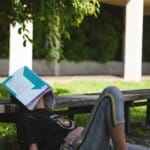






Second Thoughts on Keeping Kids Safe by Never Letting Them Out of Our Sight — and the Enduring Myth of Stranger Danger
It goes without saying that no one wants a child to be hurt, ever.
Sometimes, though, it seems as if we believe that with enough child-surveillance, parent-surveillance, blaming, shaming, investigating and arresting we can achieve perfect childhood safety: Just make sure kids are watched 24/7 — and hound the parents who don’t do that.
That’s why we really have to think about actual safety and not just the knee-jerk response: “Never let them out of our sight till they’re 18!”
So here’s a list of things to think about when considering which practices, precautions and laws make kids safer — and which may FEEL “protective” but actually aren’t.
1: “Unsupervised” does not equal “unsafe”
Considering that vast majority of child abuse is at the hands of someone they know, rather than a stranger (see this DOJ report, page 10), it begins to feel as if keeping kids indoors — with a babysitter, parent, relative, sibling, or step-parent — is actually LESS safe than them getting on their bikes and riding around. Let’s not restrict kids’ freedom due to a misunderstanding of actual risk.
2: The surprise about crime rates
While it certainly feels as if there are more child predators and crimes against children today, the FBI stats say otherwise. Crimes against children have fallen since the early ’90s.

Some say, “That’s because we are helicopter-parenting them!” But crimes against adults have fallen during that same period and we don’t “helicopter parent” them. It’s just a true but surprising fact that crime has jack-knifed DOWN since the early ’90s. (With an uptick in 2020 due to a truly abnormal year.)
But thanks to media obsessed with the very worst, scariest stories, most people think crime is UP. As the Pew Research Center noted just this past November:
In 20 of 24 Gallup surveys conducted since 1993, at least 60% of U.S. adults have said there is more crime nationally than there was the year before, despite the generally downward trend in national violent and property crime rates during most of that period.
3. “Stranger Danger” gets it all wrong
The best way to keep kids safe is NOT to teach them “stranger danger.” That’s according to the National Center for Missing and Exploited Children — the folks who put the kids on the milk cartons (and never mentioned that most were runaways or taken in custody disputes).
The best practice to keep kids safe from sex crimes is to teach them the 3 R’s:
- Recognize it. No one can touch you where your bathing suit covers.
- Resist it. Scream. Fight. Run.
- Report it. Tell your children that if anyone makes them feel weird or wants them to keep a secret, they should always report it to you and you won’t be mad at them. This helps dissipate any guilt and destroys the secrecy predators depend on.
4. Trusting parents
We have to trust parents who know and love their kids more than some passerby who says, “A child outside! That’s crazy!”
Unless a parent is putting their child in a situation where egregious danger is statistically likely, there is no reason to open an investigation for neglect or abuse. Doing so is taking away the right of the parent to decide what they believe is best for their kids and their family, and taking away the right of the child to have anything more than a sort of bonsai childhood — kept safe, warm, indoors and stunted.
5. The biggest childhood danger
Those who say we cannot let kids ever be alone because of the danger may want to consider outlawing the practice of driving kids anywhere. The #1 way American children die is as passengers in moving cars.

We don’t outlaw driving kids around because we are good at keeping the danger in perspective: We know it’s not perfectly safe but it is surely safe enough. The same goes for letting kids play and roam.
6. Taming childhood anxiety
Finally, there is a yin to every yang. Give kids some independence and they may fall of their bike, get lost, or get cold. From which they can learn how much they can handle. Give kids NO independence — tell them they are in danger all the time they are not under someone’s watchful eye — and they grow up thinking the world is a dangerous place that they are unequipped to deal with.
That is the definition of anxiety.
With childhood anxiety, depression and suicide spiking (not to mention obesity) It’s unclear that keeping them “safe” and supervised all the time IS safer.
7. The safe word is “Confidence”
We all share the same concerns: We want kids to be safe, sound and loved. In a country where the crime rate is not going up, most molesting is not at the hands of a stranger (even a stranger on the Sex Offense Registry), childhood anxiety, depression and obesity are spiking as kids spend more time supervised and indoors, and even the National Center for Missing and Exploited Children is telling Americans to stop teaching kids stranger danger, it is time to give kids back some healthy independence.
When I interviewed the head of NCMEC for my book, he said that the best key to safety is confidence. Kids who have a bit of swagger and street smarts are safer than the ones constantly “coddled.”
Conclusion: Kids are not less safe today
Let us fight fear with truth: Kids today are not less safe than their moms and dads were as kids.
Most of us are very grateful we had a chance to play, wander and spend some unsupervised time as kids. It made us confident, brave, and happy.
Parents know best when their kids are ready for the next step in their lives. Let parents raise can-do kids — not perfect, stunted bonsai trees.
Photo by Sven Brandsma on Unsplash



Comments are closed for this article.